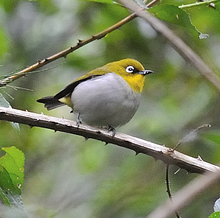Malagasy white-eye
| Malagasy white-eye | |
|---|---|
 |
|
| Scientific classification | |
| Kingdom: | Animalia |
| Phylum: | Chordata |
| Class: | Aves |
| Order: | Passeriformes |
| Family: | Zosteropidae |
| Genus: | Zosterops |
| Species: | Z. maderaspatanus |
| Binomial name | |
|
Zosterops maderaspatanus (Linnaeus, 1766) |
|
The Malagasy white-eye (Zosterops maderaspatanus) is a species of bird in the white-eye family, Zosteropidae. Found in the Comoros, Madagascar, Mayotte, and Seychelles, its natural habitats are subtropical or tropical dry forests, subtropical or tropical moist lowland forests, subtropical or tropical mangrove forests, and subtropical or tropical moist montane forests.
This white-eye grows to a length of about 10 cm (4 in). The upperparts, wings and tail are a dark olive green, the throat is yellow and the breast and belly pale grey. The white eye ring is incomplete, there being a gap at the front of the reddish-brown eye. The upper mandible of the beak is black and the lower mandible is grey. The legs and feet are greyish-blue.
The Malagasy white-eye occurs in Madagascar, Mayotte, the Comoros and the Seychelles. Small groups of these birds can be found in woodland, foraging among the branches and flitting between the trees, calling constantly to each other with a soft "pee-u".
A lively and agile bird, its flight is strong but jerky, each flight covering only a short distance. It feeds in the open during the day and moves deeper into the forest at night. It likes to bathe in pools and also makes use of water trapped in hollows in trees for this purpose. Mutual preening sometimes takes place, with two birds almost leaning on one another as they preen around the head, face and chin.
The diet consists mainly of invertebrates and fruits, also including nectar, pollen, flower buds and other vegetable matter. Insects are found by gleaning on twigs and branches, the bird sometimes clinging upside-down to the trunk of a tree. Prey is sometimes caught in the air by hawking, and the bird may hover briefly while taking food, and probe into inflorescences and lichens, sometimes becoming dusted with pollen.
...
Wikipedia

